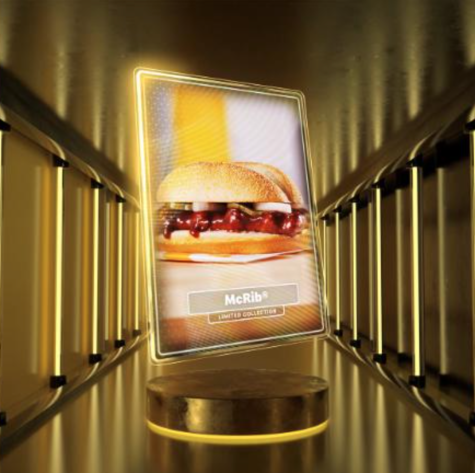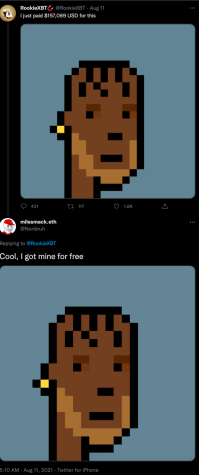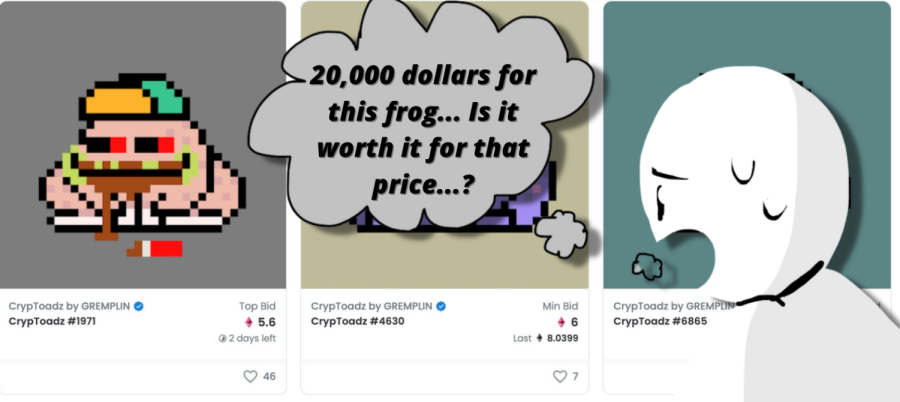The Rise of the NFT and its Flaws
NFT’s have started to catch the eye of general audiences and media, but do people know the problems with them?
NFT’s can cost over 20,000+ dollars, the frog NFT depicted on the left is 5.6 eth, which translates to $24244.97 USD.
November 23, 2021

On November 1, 2021, McDonald’s released this NFT of one of their most popular meals: The McRib. (Shown to the right) This NFT is $20, with the physical burger costing only $3.69, making a $16.31 difference. If this NFT is 2$0, then why is it so expensive?
To start, an NFT, also known as a Non-Fungible Token, is a unique and non-interchangeable unit of data stored on a digital ledger. Non-Fungible tokens use ethereum, a form of cryptocurrency. Cryptocurrency is a digital form of currency, or a collection of binary data which is designed to work as a form of exchange, where individual coin ownership records are stored in a ledger.
To get an NFT, first you buy ethereum. Ethereum is a software platform that runs on a blockchain. Users can interact with the platform using ethereum, the cryptocurrency associated with ethereum, or buy and hold it as a store of value. Then, the user would connect to a NFT marketplace, and then buy one if they have enough ethereum.
This can be a bit of a struggle to understand, but in an analogy, an NFT works like this:
Imagine if a person went up to the art piece “Starry Night” and they wanted to own the piece of art, and someone nearby the painting in the gallery went “give me 100 million dollars and I’ll burn down an unspecified amount of a forest to give you this receipt of purchase.” So, they paid the seller, and the seller said, “Here’s your receipt. Thank you for your purchase!” and went to an unmarked supply closet in the back of the museum and posted a scribbled-on label inside it behind the potted plants, labeled “Starry Night: owned by person,” so if anyone wanted to know who owns it they’d have to find this specific closet in this specific hallway and look behind those specific potted plants, and the person asks if they can take their newly owned piece home, but the seller said, “You only bought the receipt that says you own it, you didn’t actually buy ‘Starry Night’ itself, so you can’t take the real ‘Starry Night.’ You CAN take this, though,” and gave the buyer the replica print in a cardboard tube that’s sold in the museum’s gift shop. What’s surprising is that the seller that is selling the receipt of purchase to the person has at no point in time ever owned this piece.
However, when talking about burning down an unspecified amount of forest, what does that have to do with NFT’s? Cryptocurrencies and NFT’s in general are extremely harmful to the environment. NFT’s have an extremely big carbon footprint on the Earth’s environment, using environmental pollution by producing planet-heating carbon dioxide emissions generated by the cryptocurrencies used to buy and sell them. This is not helping the global warming issue occurring in our current society today. “NFT’s use 10 times more the energy than cryptocurrency, about one transaction on this network is roughly 35 kWh,” Memo Akten, a computational artist and engineer, said. This equals around the same as powering a refrigerator for a month, and all of that energy wasted in one day, is impactful to our environment, and not in a positive way at all.
NFT’s used to be a minor problem in preserving the environment, but now NFT’s have started to gain more traction and the spotlight for a number of mainstream brands. Stated before, McDonalds made a McRib NFT, The Macy’s Parade making parade-themed NFT’s, and the most hypocritical one, Disney making a Wall-E based NFT. What’s so hypocritical about making a Wall-E NFT? If a person buying this NFT knew the main plot of Wall-E they would understand. Wall-E is about said robot working to clean up the environment humans had polluted for over 700 hundred years, one trash piece at a time. Wall-E is a critique about pollution and energy wasting, but to put Wall-E in an NFT, which pollutes the environment, is an upsetting thing to see for some viewers. The rise of these tokens will soon make the environment worse the more people invest in it.
A large number of NFT investors claim NFT’s support artists, because the tokens have pieces of art created by artists in them, but most of the time, NFT’s are AI-generated pieces of art, or stolen art. According to Anil Dash, the original creator of NFTs says “[…]all of today’s popular NFT platforms still use the same shortcut. This means that when someone buys an NFT, they’re not buying the actual digital artwork; they’re buying a link to it. And worse, they’re buying a link that, in many cases, lives on the website of a new start-up that’s likely to fail within a few years. Decades from now, how will anyone verify whether the linked artwork is the original?” NFT’s are so flawed, even the creator points it out. Many artists working hard just for a regular wage when they see their art get stolen or art that is generated by a computer sells for way more plus causes more harm to the environment than their piece, is going to majorly affect the artists money gain if more people invest in NFT’s.

Thankfully, the majority of people seem to be able to point out the flaws of NFT’s, and always have their ways of finding light-hearted fun. For example, many people who invest in an NFT will post a picture onto their social media, saying they ‘own the piece’, only to get an army of people in their comments saying they own it now, because they screenshotted or right-clicked the image. (Shown on image to the left). There are alternatives for NFT’s and that is to commission an artist.
Commissioning an artist not only gives money to an artist most likely struggling, but also is less likely to harm the environment. Plus, art commissions usually are custom made, so that means a completely custom piece of art paid for most likely a smaller amount, that does not harm the environment, and get complete ownership of the piece, is an extremely better deal then the AI-generated art the NFT’s produce. To conclude, before purchasing an NFT, look back at its flaws and find alternatives to purchasing them, to make the environment just a bit cleaner, a little can mean a lot.


